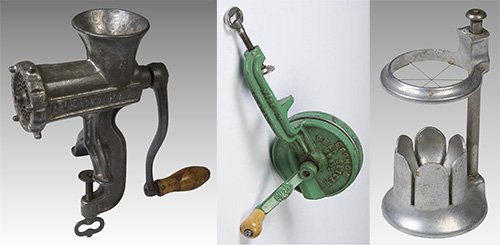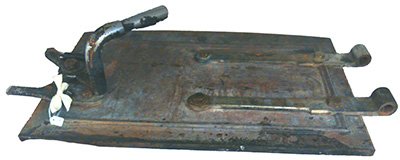Obscuratorial Finds – Why do we have so many…?
by Alice Quine, Curatorial Assistant
In a practising Jewish household, food plays a very important role in religious holidays and celebrations. Many Jews keep kosher, whereby they only eat meat and dairy products which have been prepared in a ritually proper manner, and which must never be mixed or eaten together. At the Jewish Museum we hold many household objects used in cooking, which reflect both Jewish practice and general British trends.
Koshering Boards – These are used to draw blood out of meat, which must be done to make it kosher. While the shape might seem impractical, its slanted base and curved corners ensure the meat is cleanly and fully prepared. The museum holds many of these boards in a variety of sizes and designs, which does make them a bit of a drain on storage space. However the important role they play in Jewish custom means we shan’t get bored of them yet.

Meat Koshering Board, circa 1955
Kitchen Gadgets – Some of the cooking utensils in the collection are not specifically related to Jewish custom, but offer an interesting insight into the revolution of kitchen appliances. A number of items we have are designed to slice or mince specific foods, possibly a sign of more intricate cooking techniques (or a mild obsession with making things really small). They may also reflect the types of foods which were commonly eaten, as the food market in the 20s, 30s and 40s was significantly more limited than it is today. As with any objects in a museum, it is important to ensure that these are free of trace organic material before they are added to the stores. There would be egg on our faces as well as the slicer if a pest infestation was triggered.

L to R: Husqvarna Meat Mincer, 1920s; Spong Bean Slicer, 1930s; Tala Egg Slicer, 1940s
Ladles – The museum is the proud owner of not one, not two, but four metallic ladles – though two is perhaps illustration enough. These ladles might have been used for soup, which would have been a common food eaten in the East End of London due to its economical use of meat and vegetables, capable of feeding large families on a small budget. Though worn through use the ladles are still in excellent condition, reflecting their high quality production and the need for objects to last longer due to lower wages and scarce resources, particularly during the war periods.
For the scoop on soup at the Jewish Museum you can learn more in the Social History Gallery, and sample some yourself in the museum café: jewishmuseum.org.uk/cafe

Metal ladles with enamel coating, possibly used for soup
Bonus Oven Door – No blog post would be complete without a rusty oven door hinged to the end. This object was taken from Goldring’s Bakery, a popular East End establishment founded by Jacob Goldring, which operated from the 1910s to the 1980s. Unlike the others mentioned above, this object is not part of a domestic appliance. However, Jewish bakeries play an integral role in many Jewish households, as they provide special breads and cakes for religious holidays and family meals, which cannot be purchased at regular supermarkets.
